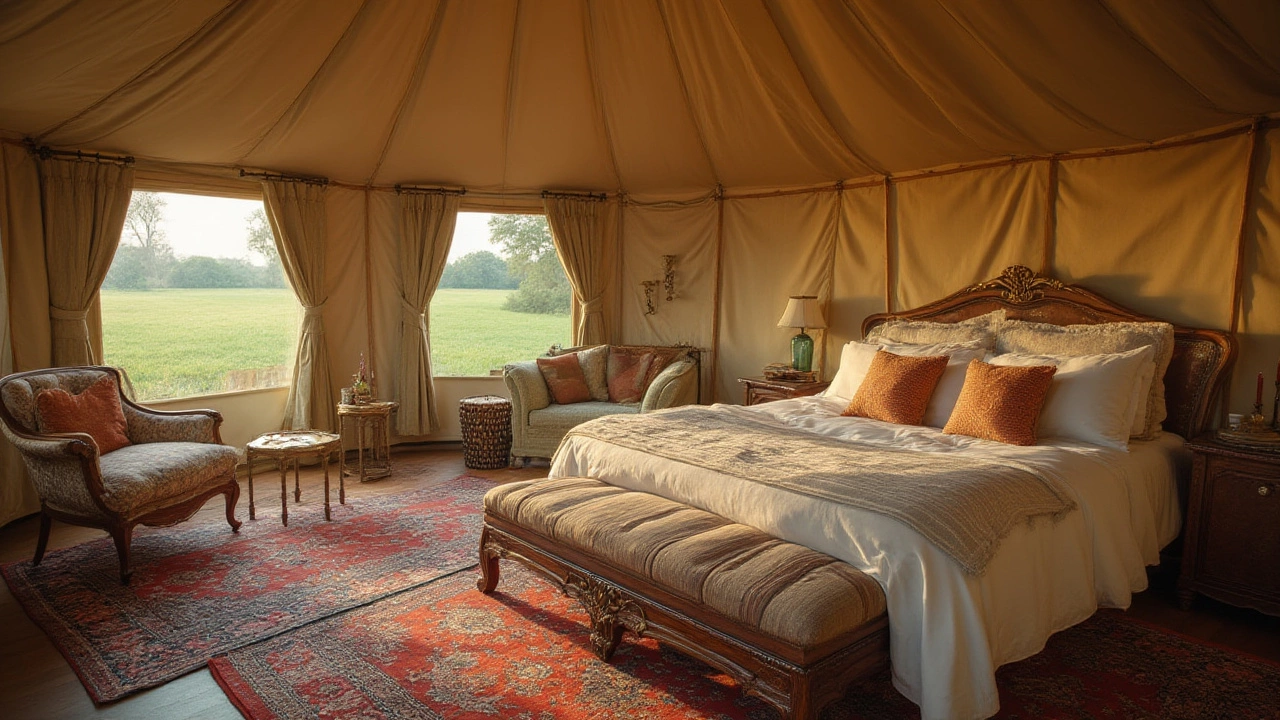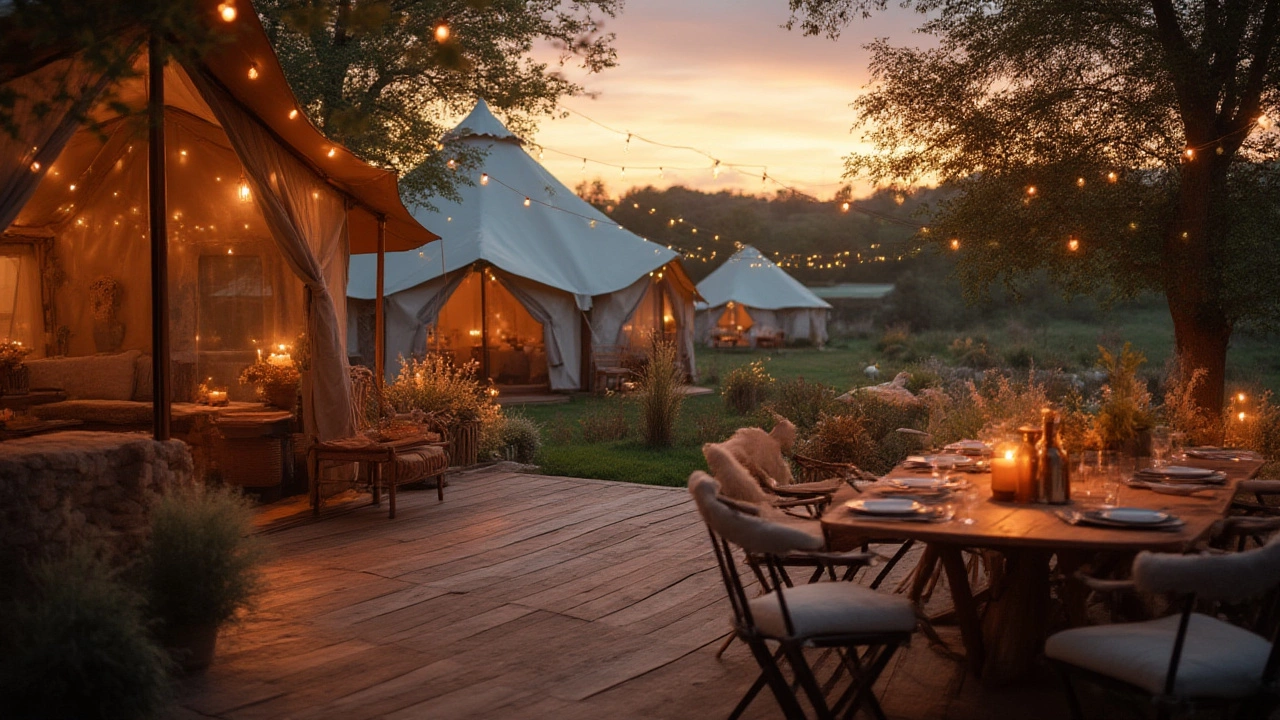Forget bug-ridden tents and cold beans on a burner. Fancy camping has a name, and it’s called glamping. Imagine waking up in a king-sized bed, the canvas walls of a yurt fluttering in the morning breeze, while someone delivers you a French-press coffee right to your door. This isn’t make-believe. Glamping is the real deal, and it’s exploded across the world for people who crave a deep dive into nature but don’t want to say no to comfort. There’s something a bit cheeky about soaking in a clawfoot tub under the stars or sipping a local wine on a deck overlooking rolling hills. But why compromise on comfort? Glamping lets you enjoy both the rugged outdoors and the soft life at the same time.
What Exactly is Glamping?
Glamping stands for “glamorous camping.” It’s all about taking the best parts of camping—being close to nature, unplugging from tech, breathing fresh air—and smashing them together with the comforts you'd expect at a posh hotel. Forget pitching a tent in a muddy field; glamping might mean sleeping in a safari-style tent with wooden floors, or a treehouse bolted high in the forest canopy, or even a retrofitted airstream trailer with all the mod cons. People are catching onto this, and fast. Booking.com’s 2024 report flagged a 30% increase in glamping bookings compared to regular campsites. Clearly, the word’s out: nobody likes sleeping on stones.
The options vary. Some glampsites lean towards rustic luxury, using vintage accessories and wood-burner stoves. Others are all about modern chic—think eco-pods with heated floors, en-suite bathrooms, and minibars. For many, what sets glamping apart is that sense of adventure wrapped in a warm duvet. And the point isn’t just about avoiding discomfort—it’s about savoring the outdoors with your senses wide awake.
There's a long tradition behind this trend. The first glampers? Turns out, Mongolian yurts and Ottoman sultan tents were essentially glamping before the word existed. European aristocrats took luxury tents on safari, kitted out with Persian rugs, chandeliers, and full staff.
- Glamping means hassle-free camping. You arrive, and everything is set up, often including fresh linens and a welcome basket.
- Electricity, Wi-Fi, and hot showers are standard at many glampsites, but there are still off-grid options for those after a digital detox.
- Several Irish sites offer vintage gypsy caravans, hobbit huts, and even floating cabins.
And there’s no age limit. Families, couples, and solo travelers all jump on the glamping bandwagon. It suits anyone who wants to experience the outdoors—without the backache and cold feet.
Types of Glamping: Not Just Fancy Tents
If you thought glamping was just about fancy tents, you’d be missing most of the magic. The range is wild. On one end, you have classic bell tents and tipis—canvas stretched over wooden frames, decked out with real beds and heated blankets. On the other end, you get jaw-dropping setups like glass igloos in Finland, letting you watch the Northern Lights from bed, or vintage airstreams in Cornwall kitted out with neon signs and record players. Even treehouses get the luxury treatment, with spiral staircases, rainfall showers, and fully stocked kitchens.
- Glamping covers yurts, safari tents, airstreams, geodesic domes, pods, chalets, eco-lodges, shepherd’s huts, cabins, treehouses, and even cave dwellings.
- Safari tents are often inspired by African safari expeditions, offering canvas tents with hardwood floors and private en-suites.
- Yurts provide a circular haven, often with wood stoves, in places like the west of Ireland and the Scottish Highlands.
- PODS—think Hobbit-style: wood-paneled, cute, and cozy, but also insulated with electric heating.
- Some farms let guests stay in fully fitted vintage caravans or even shepherds’ wagons.
- Treehouses turn the childhood dream on its head, raising the standard with proper bathrooms and jaw-dropping views.
The price can swing from €60 a night for a simple pod to €850+ for a private island yurt with a butler in tow. But even the entry-level glamping options feel a world apart from pitching your own tent in a field. Some companies even provide on-site chefs, spa treatments, or adventure guides for kayaking and horseback riding. Here’s a quick look at a few common glamping setups and what to expect:
| Type | Key Features | Typical Price (EUR, per night) |
|---|---|---|
| Bell Tent | Canvas, real bed, often with power, sometimes en-suite | €70–€120 |
| Treehouse | Elevated, luxury decor, private bathroom, decks with views | €130–€500 |
| Yurt | Circular structure, woodstove, plush bedding | €90–€300 |
| Airstream | Vintage vibe, kitchen, en-suite facilities | €100–€250 |
What’s fun is that no two glamping experiences are alike. Some are carefully curated escapes, while others are run by relaxed hosts who leave you to your own devices but with everything you need at hand. Pet-friendly options are popular, too, and you often find quirky touches—like outdoor pizza ovens for campfire feasts or hammocks for lazy mornings with a book.

Why Glamping Appeals: Comfort Meets Adventure
No, it’s not all about Instagrammable moments with fairy lights (though that’s a perk). At its heart, glamping works because it bridges the gap between wild and comfortable. There’s something deeply refreshing about falling asleep to the sound of crickets, but knowing you’ll wake up rested on a proper mattress. Privacy is a big draw—glampsites tend to be small, so say goodbye to the classic crowded campsite vibe. For families, this means less stress and more fun. You can let the kids roam while you enjoy a slower pace.
- Accessibility wins fans—no special camping skills needed, no wrestling with tent poles after a late arrival.
- It can be as active or as chill as you want, from wild swimming and bushcraft classes to simply reading by the fire.
- Most glampsites these days are eco-conscious—think compost loos, solar panels, and upcycled materials.
Glamping doesn’t have to mean splurging, either. “Pop-up” weekends and off-season deals can make luxury camping way more affordable. Some places even offer “workcations,” where you can tap into Wi-Fi in a stylish pod and then hike the hills during lunch.
Real food’s a hook as well. Forget packet noodles—expect farm-fresh eggs, local cheese, and barbecued steaks. A lot of glampsites are located on working farms or vineyards, so you can get to know the growers and producers or join in a cider-making class.
Polls by Irish travel sites in early 2025 rated glamping among the top three holiday choices for groups wanting to reconnect away from screens and traffic. It’s a safe bet—you get nature, comfort, and a proper sense of escape all rolled together.
How to Choose and Enjoy Your First Glamping Adventure
Picking where and how to glamp might feel overwhelming at first, but here are some tips for a smooth start. First, decide how far off the grid you want to go. Some sites are close to towns, while others sit on miles of forest tracks or hidden by lakes. Want Wi-Fi or planning a digital detox? Check ahead, because the spectrum runs from fully connected to blissfully signal-free.
- Think about your sleeping style. Want big beds, feather duvets, and heating? Focus on glampsites that shout about comfort.
- Location matters. Whether it’s cliffside views in Donegal, forest hideaways in Devon, or lakeside spots in Killarney, glamping works wherever there’s scenery.
- Read reviews and browse photos—Instagram can be your pal here, but don’t just trust glossy shots. Look for honest comments about hosts and on-site quirks.
- Consider activities. Some glampsites include stargazing, bushcraft workshops, or kayak tours. If you’re keen on adventure, scope out what’s included or nearby.
- Avoid overpacking. Most spots supply everything you’ll need apart from clothes and a good book. Still, check the site’s FAQ for extras like towels or slippers.
- If you’re a foodie, look out for stay-and-dine packages or sites near farms and pubs serving fresh local fare.
Glamping has loads of hidden perks, too. Couples love the romantic angle—private hideaways, open fires, hot tubs. For families, the sense of adventure is real but safe. Kids get woods to run around in and new wildlife to spot, and you don’t have to worry about damp sleeping bags or collapsed tents in a midnight gale.
In Ireland alone, the glamping scene keeps growing. By 2025, it’s not unusual to find vintage circus wagons in Galway, turf-roofed cabins in Sligo, or coastal airstreams scattered along the Wild Atlantic Way. Most places open from spring to late autumn, but heated pods and log-burners mean some sites run year-round.
Ready to try it? Book ahead for summer weekends—especially at the sites with quirky options or those famous Bubble Domes for stargazing. Take a break from your regular four walls and let nature, a fancy mattress, and maybe even a wood-fired hot tub show you what camping can really be.
